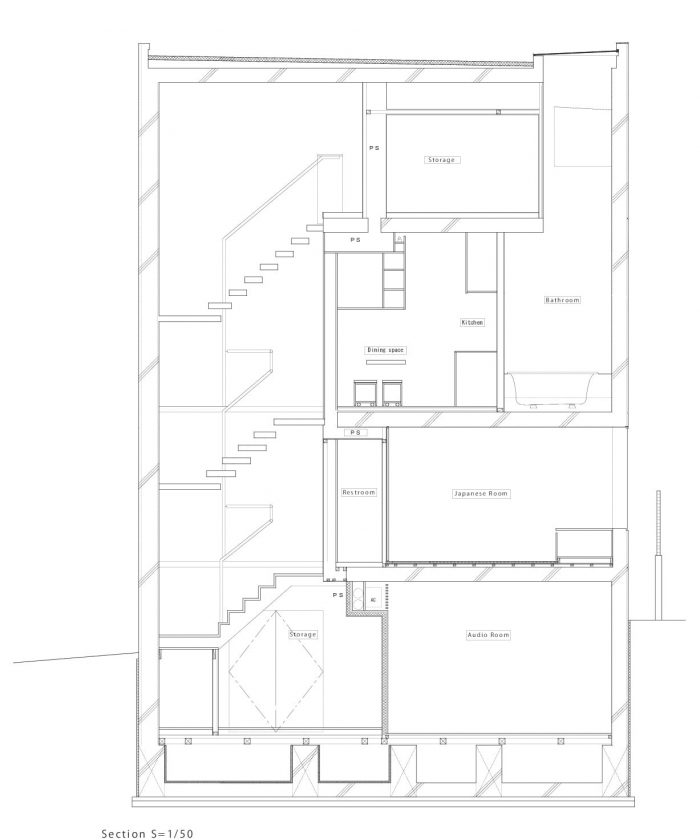在这个项目中,我们开发了一种100%可回收的混凝土,其中含有SHIRASU,即在日本南部地区大量发现的火山灰热碎流的沉积物,取代了沙子。这种混凝土的优点是它的强度和耐久性,由于SHIRASU的沸石反应,在很长一段时间内会增加。此外,它的密度来自于SHIRASU的细颗粒,可以保护混凝土不被中和。SHIRASU还含有微型封闭细胞,使混凝土具有湿度控制和除臭功能。这种SHIRASU混凝土的开发和使用对那些可以挖掘SHIRASU的地区来说是一笔巨大的财富。
For this project, we developed a 100% recyclable concrete which, instead of sand, contains SHIRASU, the deposit of pyroclastic flow of volcanic ash which is found in the Southern parts of Japan in abundance. The advantage of this concrete is its strength and durability that increases to grow over a long period of time because of the pozzolanic reaction of SHIRASU. Also its density, which comes from the fine granularity of SHIRASU, protects the concrete from neutralization. SHIRASU also contains micro closed-cells which gives the concrete humidity control and deodorizing qualities. This development and use of SHIRASU concrete can be a huge asset to those areas where SHIRASU can be excavated.
从平面认知到截面认知的过渡
对于小场地上的建筑,断面和体积设计变得非常重要。在地下室有一个高水平的隔音视听室,在一楼有一个宽敞的画廊和一个日本房间。二楼的功能被优先考虑,有客厅、餐厅、厨房和浴室。客厅是一个非常小的空间,但5米高的天花板和一个大的斜三角窗,吸引了大量的外部光线,导致了一个远大于现实的认知。这个空间的最终设计是通过大量的三维模型得出的。
三个设计方法,实现了物理和心理上的丰富性。
Transition from the planimetric cognition to the cross-sectional cogitation
For architecture on a small site, sectional and volumetric design becomes very important. A high level sound insulated audio visual room in the basement, and a spacious gallery and a Japanese room is placed on the first floor. Functionality was prioritized on the second floor with a living room, dining room, kitchen and bathroom. The living room is a very small space, but a 5m high ceiling and a large oblique triangular window, drawing in an abundance of external light, results in a cognition that is far greater than the reality. The final design of this space was derived through a vast number of three-dimensional models.
Three design methods that achieve physical and psychological richness.
1. “NU-KE(努-凯)” 利用室内和室外的视觉和心理联系,”NU-KE “通过墙体和空间体量的多层化,”扩大 “了空间,增加了深度。 我从长方形建筑中修剪掉一些角落,创造出面向天空的 “NU-KE”;这是东京最后一片广阔的自然。
1. “NU-KE (noo-kay)” Using visual and psychological connections between interior and exterior, “NU-KE” “enlarges” space and adds depth by multi-layering of walls and spatial volumes. I pruned away some corners from the rectangular building to create “NU-KE” towards the sky; the last remaining vast piece of nature in Tokyo.
2. 平面/剖面的同时思考
我总是同时绘制平面图和剖面图,并制作大量的研究模型,以创造一个多层次的空间,增强空间感。即;从地下室的混凝土台阶的分层,生活空间延伸到上面的卧室,厕所和高窗通向天空和卧室,浴室通过天窗通向外部。这些相互联系产生了空间上的丰富性,不能仅仅用面积来衡量。
2. Simultaneous Contemplation of plan/section I always draw plans and sections simultaneously and make numerous study models to create a multi-layered space with an enhanced spaciousness. i.e.; the layering of concrete steps from the basement, the living space extending to the bedroom above, the toilet and high window leading to the sky and the bedroom, the bathroom to the exterior via a skylight. These interconnections produce spatial richness that cannot be measured by area alone.
3. 颜色和纹理
在这里,我使用了裸露的混凝土、染成木炭和柿子皮的木板、锤击的钢、黑色不锈钢、氧化的黑银板等。这些丰富的材料的颜色由灰色到黑色统一起来,并且都有一个哑光的质地。这种对颜色和纹理的关注创造了统一性,并使空间变得有趣和丰富。
3. Colour and texture Here, I used exposed concrete, charcoal stained and persimmon tanned wooden boards, hammered steel, black stainless steel, oxidized black silver plate etc. The colors of these rich materials are unified by a grey to black colour and all have a matt texture. This attention to colour and texture creates unity, and makes spaces interesting and enriched.
Architects: Atelier Tekuto
Area : 103 m²
Year : 2015
Photographs :Toshihiro Sobajima, Jérémie Souteyrat
Manufacturers : Dornbracht, Acor, Kitazawa Sangyo, Stoneworks, Toto
Architectural Design : YAMASHITA, Yasuhiro + MIZUKAMI, Kenji + TOMOYOSE, Atsushi/ Atelier Tekuto
Construction Management : MATSUOKA, Shigeki + NAKADE, Shuichi + KITAOKA, Tsubasa
Facility Design : Yamada Machinery Office, YAMADA Hiroyuki
Constructional Design : Jun Sato Structural Engineers, SATO Jun, INOUE Kenichi
Cooperative University : NOGUCHI Takafumi
City : Tokyo
Country : Japan










